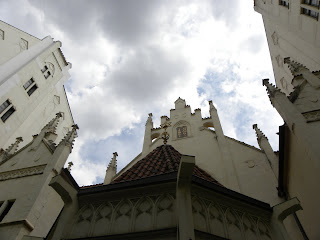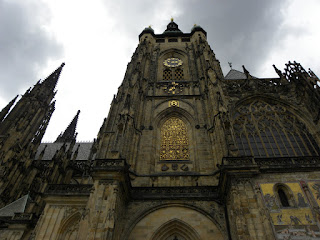A famous Jewish joke goes something like this (Uncle N., correct me if I'm wrong): A Jewish man was shipwrecked alone on an island. Years later, when a rescue crew finally found him, the man gave them a tour of the island, making sure to point out the two synagogues he had built. They asked why there were two synagogues for one man, and, pointing to one of them, the man responded, "Oh, that's the one I don't go to." Visiting the former Jewish quarter of Prague reminded me of the punchline of this joke. There are seven surviving synagogues in Prague, six of which are basically right next to each other--the furthest ones apart are maybe only a block apart. We toured four of the six, and each has a distinct character and unique contemporary use. We started with the Spanish Synagogue, named for its Spanish-Moorish architecture, which features a sparkling gold interior and a Jewish historical museum. Next was the Pinkas Synagogue, whose walls are covered with painted names of Czech Jewish Holocaust victims. We saw the Old Jewish Cemetery, home to thousands of gravestones dating back to the 15th-18th centuries, the continued to the Klausen Synagogue, with a beautiful baroque interior that's now home to a museum of Jewish ritual, culture, and celebration. Last was the Maisel Synagogue, a neo-gothic building that houses a museum of Jewish life specifically in Prague. They were all beautifully restored, and it was nice to see that just like in Krakow, there were so many different kinds of people touring these places and interested in the history. Still, it was a little eerie. On one hand, it was hard for me to picture someone taking all the seats out of my own synagogue at home, replacing them with glass cases filled with old pictures and ritual objects, and charging tourists money to enter the building. I can only imagine what the community members of these synagogues would think if they knew what had become of their synagogues. On the other hand, with such a small Jewish community in the Czech Republic, this is probably the best way that these synagogues can be preserved--if not as prayer houses, than as museums.
We spent the second half of the day seeing some more of the city by car and then visiting Prague Castle and the Lobkowicz Palace. The castle is like a city unto itself, and the Lobkowicz Palace is part of that city. It's a building that now houses a collection of art that was regained by the Lobkowicz family in restitution--first from the Nazis after the second World War and then from the Communists after the fall of the Soviet Union. It was an impressive collection, and the audio guide was narrated by Mr. William Lobkowicz himself, so we got to hear from him how wealthy his family really was (and now again is).
Later, we returned to the Spanish Synagogue for a concert of all types of music, including the song that helped inspire the tune of Hatikvah, Israel's national anthem, "My Country--Vlatava" by Bedrich Smetana. Tomorrow, my mom departs Prague to return to Chicago, but I'll visit Theresienstadt, the camp from where Zayde was liberated in 1945, and then fly to Israel at night. I can't believe that tomorrow is my last day in Europe, but hopefully it will be an educational and meaningful one. More later!

Back at the Spanish Synagogue for an evening concert





No comments:
Post a Comment